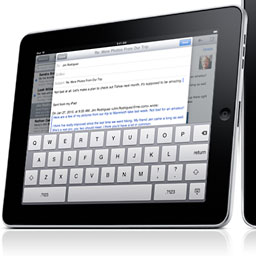Great Mac sales was the headline news for last quarter's financial
results. Most analysts (including me) thought the
iPhone would do better. The gap between iPhone and Mac sales, however,
is still widening. With an average selling price of around $600, the
iPhone brought in $5.3 billion and Macs $4.45 billion. When the sales
for the iPod touch are added in - up 55% over last December - the
difference between the OS X hardware platforms in both unit sales
and revenue is much larger.

The iPad will widen this gap.
Many people don't like computers. They don't understand them or want
to understand them. They tolerate them because they need to use them at
work or need to hit the Internet at home. Life is just too inconvenient
without them.
What they want is a sealed appliance that works, using natural
gestures they don't have to remember. The more of these people who use
touch, the less they will want to use a GUI like Windows. Remembering
how to use a computer or a program is unnecessary and too much like
hard work.
It was this sealed appliance approach that Jobs previously tried
with the Cube, but that
required a keyboard and mouse, etc. It was just another computer. With
the iPad, an external keyboard, mouse, etc. is optional. You don't need
it to reach the Web, and that is a huge psychological difference if all
you can do is "hunt and peck" on the keyboard.
The computing world will fracture into those who need to touch type
and those who like to touch.
Apple Is in the Lead
The iPhone/iPod touch platform took over from Macs as the main Apple revenue driver
in Q3 FY08, the July quarter. With over 75 million shipped, probably
twice as many people use OS X on an iPhone or iPod touch as on a
Mac or MacBook. As Steve Jobs pointed out in the iPad launch, Apple is
now the largest mobile company by revenue, although for those who
believe units are more important than revenue and profits, Nokia
(Symbian) and Microsoft (Windows) are still ahead.
For Apple, more of the future looks to be ARM-based. The iPad
shows what can be achieved with a custom version of the ARM processor
designed by the engineers who came with the PA Semi purchase. The
A4 is
fast without killing battery life, and it moves Apple away from
standard chips without losing the benefits of the ARM reference
designs.
The chips are still relatively cheap, can be updated every year,
and, unlike with the PowerPC, there is no risk of falling behind the
other volume CPU manufacturers. ARM will continue to be the standard
mobile chip until Intel can produce an x86 with great performance that
isn't power hungry. Only then will Intel be a serious competitor
outside of laptops,* but if it takes too long, the software catalog on
ARM-based devices will rival that on Windows, and Intel will have lost
its main advantage.
No doubt Apple will also look to move the A4, or a variant, to the
iPhone to widen the perceived performance gap with RIM, Android, and
Nokia. While most people will choose a carrier based on coverage and
cost, whether for work or home, accessing the Web and running apps are
next on the list for many wanting a smartphone. So the faster they can
visit websites and the faster they see the apps respond, the more
likely they are to buy an iPhone (or an iPod touch).
Apple's customization of the ARM architecture will also make it more
difficult to copy the design and do a Psystar.
The longer it takes to reverse engineer the chip, the more lead time
before competitors can catch up. This means the Chinese Shenzhen copies will
continue to be surface only iPhone lookalikes, and competitors with
more resources will be forced to design a better phone or exist on thin
commodity margins.
IPS
screens on the iPad and iMacs could lead to iBooks, Apple's ebook
reader, being right across the range. While there have been teething
troubles with the 27" iMac, judging by desktop sales (up 70%
year-over-year), customers can see the difference. If these screens,
with their great color reproduction and wide viewing angle, are added
to MacBooks too, how long before the ebook reader appears on the mouse
and keyboard range?
Ebook Potential
This could really drive an ebook takeover of the college market.
Students already need a computer. Textbook publishers could offer site
licenses and update as often as necessary. Students could get their
reading lists as part of tuition fees. With the best ebook reader and
screen, Apple will be even more strongly entrenched in education. So in
this sense at least, Apple stands at the intersection of Liberal Arts
and Technology.
As a first step, the technical and scientific journals could go this
route. Publishers already bundle their titles and negotiate site fees
with the universities, and this would reduce costs, speed distribution,
and allow for much more color illustration. As soon as this is seen as
working, reference manuals are likely to follow, because it allows for
more frequent updates, annotation, and adding sections to other
documents. In a few years, widespread ePub readers could start
undermining Adobe's PDF empire.
With its $500 million LG contract, Apple has locked up a good source
of IPS screens, no doubt on favorable terms. As with flash memory,
rival manufacturers will have to scramble and pay more for components
if this market really takes off. The aggressive pricing on the iPad
will make it difficult to profitably sell a rival tablet, and the low
price of netbooks means that ePub readers will have to work on current
screens.
While people can see the difference, many of them will pay more for
the Apple advantage. 



